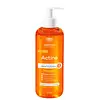What's inside
What's inside
 Key Ingredients
Key Ingredients

 Benefits
Benefits

 Concerns
Concerns

 Ingredients Side-by-side
Ingredients Side-by-side

Water
Skin ConditioningDecyl Glucoside
CleansingPolysorbate 20
EmulsifyingCeteareth-60 Myristyl Glycol
EmulsifyingGlycerin
HumectantDisodium Cocoamphodiacetate
CleansingSodium Lauroyl Sarcosinate
CleansingMethyl Gluceth-20
HumectantAlcohol
AntimicrobialAloe Barbadensis Leaf Extract
EmollientBenzoic Acid
MaskingCetrimonium Bromide
AntimicrobialCucurbita Pepo Seed Oil
EmollientDisodium EDTA
EDTA
Parfum
MaskingLactic Acid
BufferingMenthyl Lactate
MaskingMethylparaben
PreservativePhenoxyethanol
PreservativePropylene Glycol
HumectantPropylparaben
PreservativeZinc Gluconate
Skin ConditioningWater, Decyl Glucoside, Polysorbate 20, Ceteareth-60 Myristyl Glycol, Glycerin, Disodium Cocoamphodiacetate, Sodium Lauroyl Sarcosinate, Methyl Gluceth-20, Alcohol, Aloe Barbadensis Leaf Extract, Benzoic Acid, Cetrimonium Bromide, Cucurbita Pepo Seed Oil, Disodium EDTA, EDTA, Parfum, Lactic Acid, Menthyl Lactate, Methylparaben, Phenoxyethanol, Propylene Glycol, Propylparaben, Zinc Gluconate
Water
Skin ConditioningSodium Cocoyl Isethionate
CleansingGlycerin
HumectantGlycol Distearate
EmollientSodium Cocoyl Glutamate
CleansingCocamidopropyl Betaine
CleansingSodium Lauroyl Sarcosinate
CleansingCetearyl Alcohol
EmollientPhenoxyethanol
PreservativeAcrylates/C10-30 Alkyl Acrylate Crosspolymer
Emulsion StabilisingArginine
MaskingPropylene Glycol
HumectantSodium Chloride
MaskingXanthan Gum
EmulsifyingEthylhexylglycerin
Skin ConditioningNiacinamide
SmoothingPanthenol
Skin ConditioningAloe Barbadensis Leaf Juice Powder
Skin ConditioningPantolactone
HumectantCitric Acid
BufferingWater, Sodium Cocoyl Isethionate, Glycerin, Glycol Distearate, Sodium Cocoyl Glutamate, Cocamidopropyl Betaine, Sodium Lauroyl Sarcosinate, Cetearyl Alcohol, Phenoxyethanol, Acrylates/C10-30 Alkyl Acrylate Crosspolymer, Arginine, Propylene Glycol, Sodium Chloride, Xanthan Gum, Ethylhexylglycerin, Niacinamide, Panthenol, Aloe Barbadensis Leaf Juice Powder, Pantolactone, Citric Acid
 Reviews
Reviews

Ingredients Explained
These ingredients are found in both products.
Ingredients higher up in an ingredient list are typically present in a larger amount.
Glycerin is already naturally found in your skin. It helps moisturize and protect your skin.
A study from 2016 found glycerin to be more effective as a humectant than AHAs and hyaluronic acid.
As a humectant, it helps the skin stay hydrated by pulling moisture to your skin. The low molecular weight of glycerin allows it to pull moisture into the deeper layers of your skin.
Hydrated skin improves your skin barrier; Your skin barrier helps protect against irritants and bacteria.
Glycerin has also been found to have antimicrobial and antiviral properties. Due to these properties, glycerin is often used in wound and burn treatments.
In cosmetics, glycerin is usually derived from plants such as soybean or palm. However, it can also be sourced from animals, such as tallow or animal fat.
This ingredient is organic, colorless, odorless, and non-toxic.
Glycerin is the name for this ingredient in American English. British English uses Glycerol/Glycerine.
Learn more about GlycerinPhenoxyethanol is a preservative that has germicide, antimicrobial, and aromatic properties. Studies show that phenoxyethanol can prevent microbial growth. By itself, it has a scent that is similar to that of a rose.
It's often used in formulations along with Caprylyl Glycol to preserve the shelf life of products.
Propylene Glycol is an odorless, colorless liquid. As a humectant, it helps skin retain moisture. It also aids in delivering active ingredients.
Another role of this ingredient is preventing a product from melting or freezing. Propylene glycol also adds antimicrobrial properties to a product, elongating product lifespan.
This ingredient is considered an organic alcohol and commonly added into both cosmetics and foods.
Those with sensitive skin or conditions may develop a rash when using this ingredient.
Learn more about Propylene GlycolSodium Lauroyl Sarcosinate is a cleansing agent and emulsifier. It is a surfactant derived from sarcosine, and a common source is coconut oil.
As a surfactant, Sodium Lauroyl Sarcosinate helps lift dirts, oil, and other molecules to be washed away. In leave-on products, this ingredient is used as an emulsifier. Emulsifier help prevent ingredients such as oils and waters from separating.
Sodium Lauroyl Sarcosinate is also commonly found as a foaming agent in shampoo, toothpaste, and shaving foam. It is amphiphilic, meaning it loves both water and fats.
Water. It's the most common cosmetic ingredient of all. You'll usually see it at the top of ingredient lists, meaning that it makes up the largest part of the product.
So why is it so popular? Water most often acts as a solvent - this means that it helps dissolve other ingredients into the formulation.
You'll also recognize water as that liquid we all need to stay alive. If you see this, drink a glass of water. Stay hydrated!
Learn more about Water